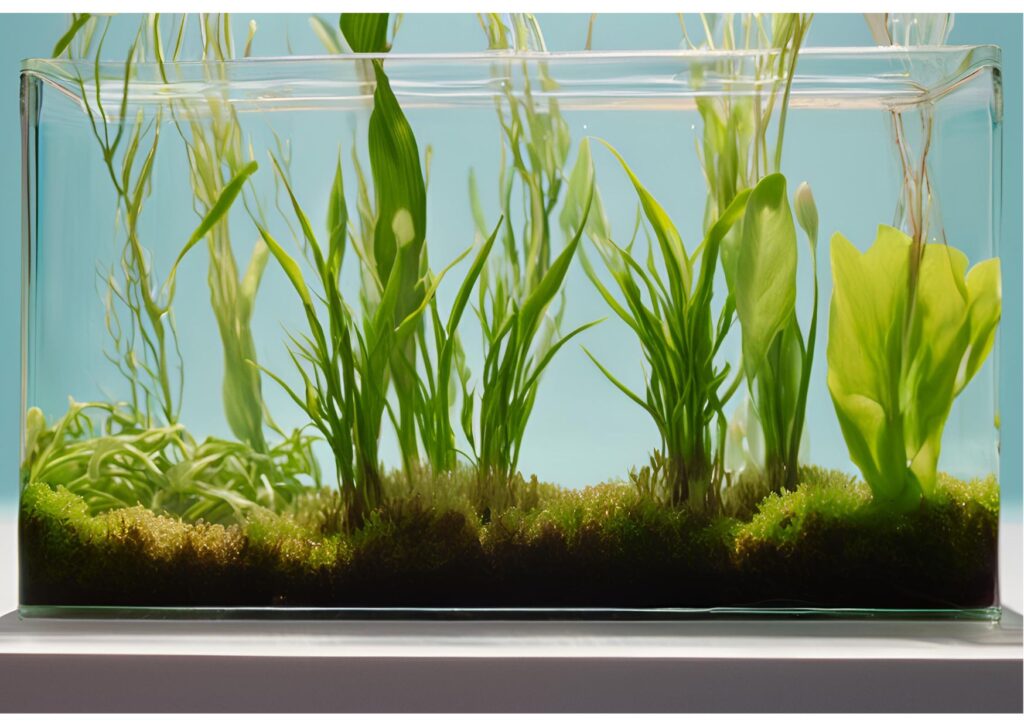Top 10 Rapidly Growing Plants for Algae Control

Adding live aquatic plants to your aquarium not only enhances its appearance but also serves a practical purpose by naturally combating algae growth in planted tanks.
- Benefit of live aquatic plants:
- They help fight against algae by outcompeting them for light and nutrients.
- Fast-growing plants play a crucial role in maintaining water quality.
- They absorb excess nutrients like nitrate and phosphate that algae require to thrive.
- Advantages of having more plants:
- More plants mean better defense against algae outbreaks.
- Increased plant population leads to a healthier ecosystem in the tank.
- The presence of live plants reduces the time and effort needed to deal with algae issues.
By fostering a balance where plants thrive, algae struggle to establish themselves, resulting in a visually appealing and algae-resistant aquarium. Enjoy a clearer tank and spend less time battling algae, thanks to the natural benefits of live aquatic plants!
1. Salvinia Natans
Salvinia Natans: The Fast-Growing Floating Fern
- Salvinia Natans, commonly known as Floating Fern, is a fast-growing floating fern characterized by its unique nickel-sized leaves and fuzzy texture.
- Unlike many other floating plants, Salvinia Natans doesn’t have long roots trailing into the water column; instead, it forms dense mats on the water’s surface.
- These dense mats effectively block light penetration below, which helps in preventing algae growth.
- The rapid growth of Salvinia Natans not only provides shelter for tank inhabitants but also outcompetes algae for light, reducing the risk of algae blooms and fostering a balanced aquatic environment in your aquarium.
2. Red Root Floaters
Red Root Floaters: The Vibrant Algae-Fighting Plant
- Red Root Floaters are a sought-after floating plant species known for their blood-red roots and undersides.
- When exposed to high lighting conditions, their leaves can transform into a striking red color, enhancing the visual appeal of your aquarium.
- Beyond their aesthetics, Red Root Floaters serve as an effective natural defense against algae proliferation.
- These plants reproduce rapidly, forming a dense canopy on the water’s surface that shades lower tank levels, impeding algae growth by restricting access to essential light.
- With their lengthy roots, Red Root Floaters excel at absorbing surplus nutrients and harmful substances from the water, further curbing algae development and fostering a healthier aquatic environment.
3. Java Moss
Java Moss: The Versatile Aquarium Essential
- Java Moss is a fundamental component in the aquarium hobby renowned for its adaptability and low maintenance requirements.
- Thriving without the necessity of CO2 supplementation or intense lighting, Java Moss can flourish in various lighting conditions, with bright lights enhancing its growth density.
- This rapidly growing moss has the capability to create dense clusters and mats, serving as ideal hiding places for fry and breeding fish.
- For species that scatter their eggs, Java Moss’s fine fronds offer a perfect attachment surface, while its intricate branched structures provide effective camouflage against potential predators.
4. Rotala Narrow Leaf Sp. Red
Rotala Narrow Leaf Sp. Red: The Stunning Fast-Growing Stem Plant
- Rotala Narrow Leaf Sp. Red is a sought-after stem plant known for its slender leaves and striking red foliage.
- Once established, Rotala variants exhibit rapid growth, especially in environments with ample light and nutrients, capable of growing 1-2 inches per week.
- Regular trimming is essential to control overgrowth and prevent shading of lower sections in high-light setups.
- Propagation follows the standard method for Rotala species and other aquatic stem plants: simply cut along the stem and replant it into aquasoil for continued growth.
5. Egeria Densa
Egeria Densa: The Rapid Nutrient Absorbing Aquatic Plant
- Egeria Densa, commonly known as Anacharis or Elodea, is a leafy stem plant renowned for its fast growth rate.
- This plant excels at absorbing surplus nutrients from the water, effectively depriving algae of essential resources, thus mitigating the likelihood of algae proliferation.
- Ideal for establishing balance in a new aquarium, Egeria Densa’s robust growth helps stabilize the aquatic environment.
- The dense foliage of this plant offers shade and refuge for all inhabitants of the tank, enhancing the overall ecosystem.
6. Hygrophila Difformis
Hygrophila Difformis: The Aquatic Marvel
- Hygrophila Difformis, popularly known as Water Wisteria, stands out as a top choice among fast-growing aquatic plants for its rapid development and beginner-friendly maintenance needs.
- Despite its potential to reach heights, regular trimming facilitates a neat, dense growth habit that suits both compact and low-profile aquarium setups.
- Its quick growth not only ensures a flourishing appearance but also simplifies propagation through stem cuttings and replanting, making it an attractive option for aquarists seeking to boost their tank’s greenery swiftly and effortlessly.
7. Bacopa Caroliniana
Bacopa Caroliniana: A Stunning Addition to Aquariums
- Bacopa Caroliniana is a visually appealing plant for planted aquariums, characterized by its thick green leaves and upright growth pattern.
- While typically green, new growth can take on a reddish hue when provided with iron and other vital nutrients.
- Enhanced growth of Bacopa variants can be achieved through the addition of CO2, bright lighting, and adequate nutrient availability. However, this resilient plant can still thrive without any additional supplementation, making it a versatile choice for aquarium enthusiasts.
8. Hydrocotyle Leucocephala
Hydrocotyle Leucocephala: The Vibrant Brazilian Pennywort
- Hydrocotyle Leucocephala, commonly referred to as Brazilian Pennywort, is a renowned fast-growing plant featuring circular, penny-sized leaves reminiscent of clovers.
- This plant is valued for its easy-going nature and quick growth, effectively combating algae by swiftly absorbing excess nutrients in the water.
- Without regular trimming, it may overshadow other plants by out-competing them for light, leading to overgrowth. To maintain a neat, low-lying carpet appearance in the foreground, frequent pruning of new growth and adequate lighting with CO2 supplementation are recommended.
9. Vallisneria Gigantea 'Rubra'
Vallisneria Gigantea Rubra: A Striking Variation in the Vallisneria Genus
- Vallisneria Gigantea Rubra is a unique subtype within the Vallisneria genus, characterized by long leaves that may take on a reddish tint.
- This freshwater plant serves as an excellent background addition, boasting rapid and towering growth that competes effectively with algae owing to its high nutrient requirements.
- Vals plants propagate via side shoots and can swiftly reach the height of your aquarium. The plant’s quick growth rate and dense foliage contribute to a lush environment that not only provides shade but also fosters a balanced, algae-free ecosystem for all aquarium residents.
10. Pearl Weed
Pearl Weed: The Versatile Hemianthus Micranthemoides
- Pearl Weed, also known as Hemianthus Micranthemoides, is a sought-after fast-growing carpeting plant that clusters in dense, low-growing stems.
- Its rapid growth and lush foliage make it a formidable adversary to algae. When used as a foreground plant, Pearl Weed can swiftly dominate your tank if not regularly trimmed.
- With ample light and CO2 supplementation, Pearl Weed spreads horizontally to create a carpet rather than growing vertically. This expansive growth occurs quickly, enabling Pearl Weed to blanket large portions of the substrate in a short period.
- This plant excels at absorbing harmful ammonia and nitrate from the water, aiding in the prevention of algae outbreaks while contributing to a healthy aquatic environment.
Utilizing the Strength of Rapidly Growing Plants to Combat Algae
In summary, incorporating fast-growing aquatic plants into your aquarium provides numerous advantages. These plants are essential in the control of persistent algae, reducing the time spent combating outbreaks and allowing you to relish your aquarium more.
Moreover, these plants actively consume ammonia and nitrite, enhancing water quality and stability in the tank. Additionally, fast-growing plants create a secure environment for breeding fish by offering ample hiding spots and coverage for fry, ultimately increasing their survival rates.
Apart from their practical benefits, live plants enhance the visual appeal of any planted tank, imitating the natural habitats of various aquarium fish species and promoting interaction between your fish and their surroundings. By introducing the discussed plants to your freshwater aquarium, you can significantly improve your ability to combat algae and maintain a harmonious aquarium environment.


